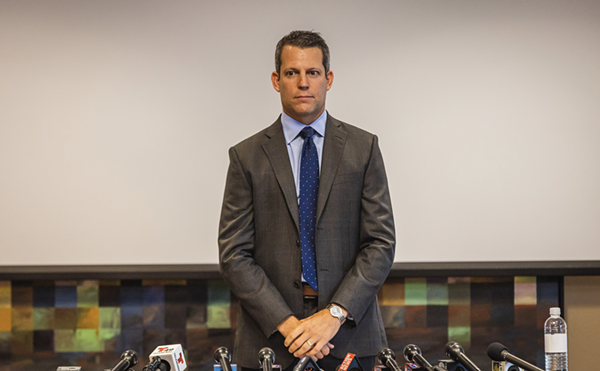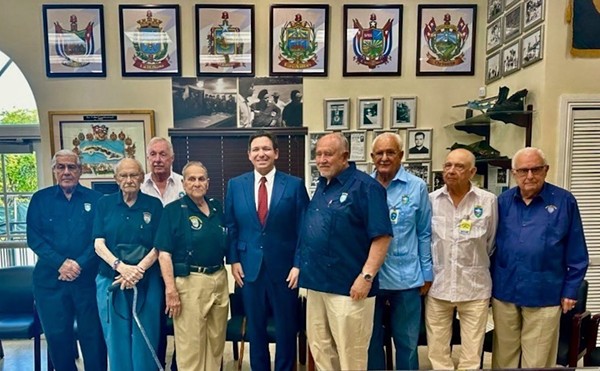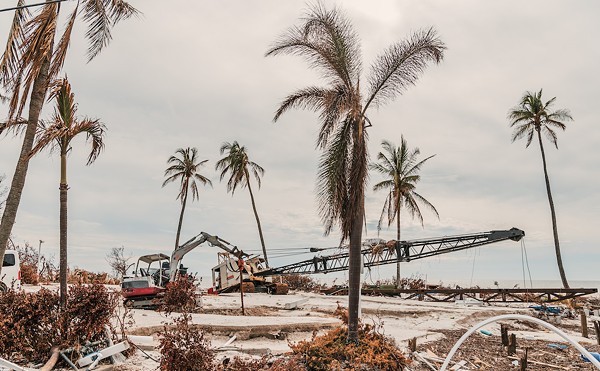Islamorada: So when did this key get cool?Think about it: Key West always gets the best press, Key Largo packs movie heat and Marathon Key is famous for fine-ass fishing. Islamorada was always just there, about halfway between Key Largo and Key West, devoid of their romance, mystique and elegant "upper crustacean" shell shops full of Philippine conchs.
In fact, the string of 43 bridges connecting those U.S. cays from Key Largo to Key West has always been pretty much just that — a ribbon of road, the only way to get to that haute Hemingway haunt at Mile Marker 1. Now those "lesser keys" are awake and soliciting dollars, just as tackily as any other U.S. tourist draw.
Islamorada (roughly translated, it means "Island Abode") is chief among them, with a gigantic two-storied World Wide Sportsman store complete with glass elevator and replica of Ernest Hemingway's wooden boat. Elsewhere along Overseas Highway (a.k.a. U.S. 1), Miami-Beach-style gift shops with $200 cigar-box purses compete with tourist draws such as Robbie's, where you can lean over a dock and hand-feed bait fish to 200-pound tarpon.
But it's during lobstering season, from August through March, that Islamorada's lure is particularly strong. Sure, there are plenty of spots up and down Florida's Gulf Coast where you can dip your tickle-stick (more on that later), but Islamorada is the most convenient, and — thanks to that huge sports supply store — the best-equipped.
That's why, faced with less than a week of vacation time during an otherwise tripless summer, I set off for Islamorada with Captain Hal Gibson, my fiancé, and Mark Jreisat, my son, for an all-expenses-paid-by-Sugar-Mama tour. Our recently purchased used 17-foot Mako made it seem like a good idea to give the boat its virgin ride during the madness of the lobstering "preseason," a two-day period at the end of July set aside exclusively for sport fishermen.
Hey, it's not every mother lucky enough to have a fiancé licensed to pilot a 100-ton vessel, much less a 23-year-old business-major offspring whose one Gen-Y-worthy goal in life is to make lots of money while impersonating an impoverished student, who never remembers a birthday and whose endearing idea of a nickname for his non-petite mother is Snapping Turtle (something to do with the chin).
Outfitting him with fins — $30 on sale — and a mask and dive-flag — $37, all on sale — was just the beginning of a three-day jaunt during which the two males on board wound up with 12 lobsters.
Nice haul — but then again, the lobsters wound up costing roughly $250 apiece.
The buying spree started at Scuba Quest in Brandon, and continued into Islamorada with the purchase of a $9.99 underwater camera and a $20 packaged set from the Islamorada Eckerd's, complete with lobster net, lobster-carapace-measuring instrument and tickle-stick.The way you catch a lobster is to tickle it with the stick, which inspires backward propulsion into your net. As for the measuring instrument, every single person on board, according to laws governing state and federal waters, must have one of these little rulers in his or her possession. The lobster is to be measured in the water, thank you very much, from the point right behind the eyes down to where the tail starts. The tail is pretty much the only edible part of the Florida spiny lobster, and "tails can be separated only on land."
Pay attention: Ignorance of the law is no excuse. If you forget your lobster-carapace-measuring instrument or you go out one minute before the season begins, the government may impose various penalties leading up to confiscation of your boat. I doubt I could talk the Coast Guard into taking my firstborn instead, or I'd be very tempted to go out early. Judging from the numbers of pickup trucks and boats invading the Keys, we're facing lots of competition.
We meet up right away with John Brummer, a city carpenters' supervisor from Hollywood who has spent three days scoping out lobster lodges and ledges in preparation for the mini-season, which the Florida Fish and Wildlife Conservation Commission calls the Sport Lobster Season. Always the last consecutive Wednesday and Thursday in July, the 48-hour period was invented to keep the hobbyists from clashing with the commercial harvesters. This is owing to the long history of bad blood, if not bloodletting, between recreational fishermen in Florida and those commercial bastards, but I'm not taking sides.
Brummer says, "I just look over the side of the boat, and when I see something I turn around and take another look. If it still looks interesting, I dive down and investigate. Today I saw a washing-machine drum."
Lobstering is not high-tech.
Captain Hal is dubious, having hunted real 5-pound lobsters in Panama, not the lame Florida crawfish, but when he and Da Kid finish scouting they are psyched. They enter six sets of coordinates into the GPS. Grown men enter figures into hand-held electronic devices like boys recording Nintendo passwords. One will lead them back to a coral head the size of a bar tabletop they found crawling with crustaceans. They also spot part of an airplane wing with a long, thin crack full of lobsters — there's some weird shit in the Atlantic.
















